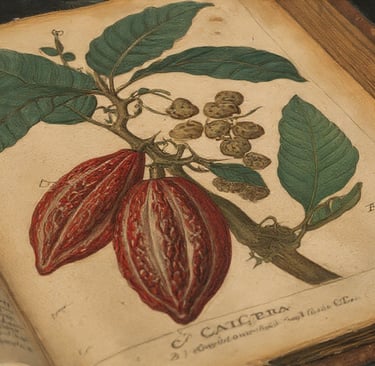From Sacred Drink to Global Obsession
The Extraordinary 4,000-Year Journey of Chocolate


Long before chocolate became a confection, a comfort, or a craving, it was a symbol—of power, of spirituality, of wealth, of ceremony. It fueled ancient kings, accompanied warriors into battle, flowed through wedding rituals, and even served as currency. Its history is not a gentle one; it is a story of empires, conquest, migration, botanical rescue missions, and the blending of cultures over thousands of years.
Chocolate, as we know it today, is barely 200 years old. But cacao’s story stretches back nearly 4,000 years, beginning not in Europe but deep in the tropical rainforests of the Americas.
This is the sweeping, surprising history of how chocolate traveled from sacred seed to global icon.
I. Before the Maya, Before the Aztecs: Cacao’s Mysterious Beginnings
The oldest known evidence of cacao consumption dates to circa 1800 BCE in what is now Honduras. Archaeologists found traces of cacao residue inside pottery—proof that ancient peoples were fermenting and brewing cacao long before any written history.
These early drinks were likely:
Fermented cacao “beer”
Mildly alcoholic
Used in ceremonies and celebrations
A marker of social status
It wasn’t sweet. It wasn’t creamy. It probably tasted earthy, slightly sour, and lightly invigorating.
Cacao’s earliest identity was neither dessert nor drink—but ritual.
II. The Maya: Chocolate as Ceremony and Civilization
By 250 CE, the Maya had elevated cacao into a cornerstone of cultural life.
They consumed a drink called xocolātl (“bitter water”), made from ground cacao, water, and spices like chili or annatto. It was frothed to create a silky top layer—a technique still used today in parts of Mexico.
For the Maya, cacao was:
Sacred, believed to be a gift from the gods
Ceremonial, used in weddings and offerings
Medicinal, prescribed for fevers, fatigue, and digestion
Symbolic of status, enjoyed by nobles and elites
Maya art often depicts kings and queens pouring chocolate from one container to another to create foam—a gesture as meaningful as a royal toast.
III. The Aztecs: Chocolate as Power and Currency
When the Aztec Empire rose between the 14th and 16th centuries, cacao traveled with them as tribute. Unlike the Maya, the Aztecs grew little cacao themselves due to climate; instead, they demanded it as tax from conquered peoples.
The Aztecs drank chocolate cold, dark, and bitter—sometimes with flowers or ground corn. They believed cacao gave:
Strength to warriors
Clarity to leaders
Vitality to nobles
Energy for long journeys
Cacao beans themselves became currency. A rabbit cost 10 beans. A turkey hen cost 100. Ordinary citizens rarely tasted chocolate—its power was reserved for rulers and warriors.
Perhaps the most famous chocolate devotee was Moctezuma II, who was said to drink 50 cups a day, each flavored with vanilla or rose petals.
IV. Chocolate Meets Europe: A Cultural Collision
In 1519, when Hernán Cortés and his men first witnessed chocolate at the Aztec court, they disliked the bitter drink. But they immediately recognized its value—and its prestige.
Cortés wrote to King Charles V of Spain:
“One cup of this noble chocolate gives a soldier enough strength to march for a whole day."
The Spanish didn’t adopt chocolate as it was. They transformed it:
Added sugar
Added cinnamon
Added vanilla
Served it warm
Removed chili and corn
Within decades, chocolate became a sensation among European elites. Monasteries refined the recipes, aristocrats flaunted ornate chocolate-serving sets, and chocolate houses emerged as social hubs.
What had once been sacred became fashionable.
V. The Industrial Revolution: When Chocolate Became Chocolate
Until the mid-1800s, chocolate was exclusively a drink. Then three inventions changed everything:
The Cocoa Press (1828) — Coenraad van Houten - Separated cocoa solids from cocoa butter, enabling smoother, less fatty chocolate.
The First Solid Eating Chocolate (1847) — Fry & Sons - Mixed cocoa butter back into cocoa powder with sugar—accidentally inventing the bar.
Milk Chocolate (1875) — Daniel Peter & Henri Nestlé - Added condensed milk, unlocking a new category of chocolate and a global market.
These innovations made chocolate affordable, portable, and mass-produced. What had been royal became everyday.
VI. The Colonial Impact: A Complicated, Painful Chapter
As demand exploded, European empires expanded cacao cultivation into Africa and Southeast Asia. New plantations depended heavily on enslaved and indentured labor—a reality that shaped the global chocolate supply chain for centuries.
By the late 1800s, West Africa became the new heart of cacao production, a role it still holds today.
Chocolate’s history is delicious, but it is not without shadows. Modern ethical sourcing efforts aim to address the legacy of exploitation that accompanied chocolate’s rise.
VII. The Fine Chocolate Renaissance: Returning to Origins
Beginning in the 1990s, small-batch chocolate makers sparked a revolution: bean-to-bar craftsmanship. They sought to:
Work directly with farmers
Pay higher prices
Support biodiversity
Celebrate regional flavor
Revive heirloom cacao varieties
This movement reconnected chocolate with its ancient roots: terroir, culture, ceremony, and care.
Today, chocolate is both global and deeply local—a food shaped by thousands of years of human migration, invention, and adaptation.
VIII. Why Chocolate’s History Matters
Chocolate isn’t just something we eat. It’s a timeline of:
Civilizations risen and fallen
Agricultural ingenuity
Trade and conquest
Ritual and identity
Innovation and artistry
Human resilience and creativity
Every bite we take is the end point of a journey that began in sacred forests, passed through royal courts, crossed oceans, endured upheaval, and inspired generations of farmers, makers, and dreamers.
Chocolate is not just a flavor—it is a story. A story still being written.
Contact
info@menloparkchocolatecompany.com
© 2025 Menlo Park Chocolate Company. All rights reserved.
Subscribe to receive special offers and to hear about new product drops!
